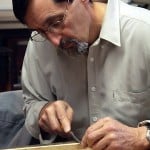Annoying wood movement…
Welcome! / Forums / General Woodworking Discussions / Annoying wood movement…
- This topic has 9 replies, 7 voices, and was last updated 11 years, 7 months ago by
Anonymous.
-
AuthorPosts
-
Hi!
I have a question about wood movement and how You handle it…
I’m working on a box like the ones Paul described in his blog made for the Henry Taylor chisels. I got some pre-milled pine from the hardware store. I chose it to be straight grained and rift sawn. It was a 800mm long, about 120mm wide and 20mm thick board. I’ve cut it into shorter pieces, with a plan to reduce the thickness to about 15mm. Knowing about the Annoying Wood Movement (AWM), first I let the boards to lay around for a week. Then I pre-planed it to about the desired thickness +1,5mm. And left it sit for 2 days. Of course the pieces cupped. So today I planed the pieces flat again and thicknessed to the desired width. I checked it about a zillion times if the pieces are flat. I left it for a while, because I was doing something else. After an hour or so, I went to laying out joinery and it turned out, that the pieces where cupped again. It wasn’t major, because it took two light swipes with the plane to flatten it out again, but still…the AWM seems to always be present. Is there a way to avoid this? Does the timber have to be in the shop for 6 months to acclimate or will it still deform after planning? I must say, that I find this quite frustrating, that I put some effort into dimensioning wood and it always moves when I leave it for a while.
Kindest regards,
Lukasz.
Anonymous21 December 2012 at 10:31 pm #5433Hi Lukasz, I’m no expert but I think the moisture content of the timber when purchased could have a lot to do with it. Also the temperature and humidity of your workshop.
I’m sure others with more experience on this will contribute and help soon.
Ken 🙂
 21 December 2012 at 11:56 pm #5446
21 December 2012 at 11:56 pm #5446I’m still new to this so others may have more to add, but here is my limited experience…
I have the same problem quite a bit. It’s best to leave the wood in your shop for a couple of weeks or so to adjust to the humidity. The wood will most likely lose moisture to the air in your shop as your shop will be drier than the wood. Cupping happens when the wood loses moisture quicker from one face than it does the other.
Something that helped me is to keep the timber out of direct sun, and make sure that air can flow freely over all faces, edges and ends to encourage it to lose moisture from everywhere at the same rate. I do this by putting some strips of wood (called ‘stickers’) about 15mm (1/2 to 3/4 inch or so) square under the board. Chances are that the board will still cup a little but it helps reduce the movement.
There is an outstanding book that tells you everything you ever wanted to know, and lots you didn’t, about wood. It’s called Understanding Wood, by R Bruce Hoadley. I’m still not completely through it yet (it’s quite dry – pun intended) but have learned a lot already. Here’s the link to the UK version on Amazon: http://www.amazon.co.uk/Understanding-Wood-Craftsmans-Guide-Technology/dp/1561583588/ref=sr_1_1?ie=UTF8&qid=1356134100&sr=8-1
George.
 22 December 2012 at 7:00 am #5449
22 December 2012 at 7:00 am #5449Good advise George and Ken. Actually, I would say something further. I usually mill stock straightway and make my joints the same day; usually immediately when I can. That way there is usually a very minimal amount of movement. I leave the jointed parts united together even if they are not glued and this constraining prevents most of the distortion tendencies you are experiencing. It’s a mistake to leave wood with one side exposed to a drier (or wetter) atmosphere and the other unable to release or absorb because in general we have no control over the atmospheric moisture content (AMC). That can change in a matter of minutes depending on many things not the least of which is steaming potatoes in the kitchen, hanging out washing or the wind blowing in from the east. I keep wood in my workshop for many months and every time I find good wood I stand ot instead of stacking it. Standing on end allows for air circulation and therefor wood acclimation. My Penrhyn Castle workshop is perfectly climate controlled because of the conservation of the castle itself so my wood is perfect after a period, but, that said, this can play havoc with newly installed wood. When we have a class and students must leave their wood overnight or even for a few days I encourage them to leave the flat boards face to face and slip it into a plastic bin liner tightly closed and as airless as possible. This really helps. When I mill many components for a class, sometimes a couple of hundred pieces, I keep the parts sized together and use shrink wrap to wrap around every surface. That works the very best because it both constrains and prevents the ingress and egress of moisture from the ends of the wood. That’s important, especially on short sections say for boxes. Always remember, life is just like wood. It comes with knots in it.
 22 December 2012 at 7:00 am #5450
22 December 2012 at 7:00 am #5450Good advise George and Ken. Actually, I would say something further. I usually mill stock straightway and make my joints the same day. That way there is minimal movement. I leave the jointed parts together even if they are not glued and this constraining prevents most of the distortion tendencies you are experiencing. It’s a mistake to leave wood with one side exposed to a drier (or wetter) atmosphere and the other unable to release or absorb because in general we have no control over the atmospheric moisture content (AMC). That can change in a matter of minutes depending on many things not the least of which is steaming potatoes in the kitchen, hanging out washing or the wind blowing in from the east. I keep wood in my workshop for many months and every time I find good wood I stand ot instead of stacking it. Standing on end allows for air circulation and therefor wood acclimation. My Penrhyn Castle workshop is perfectly climate controlled because of the conservation of the castle itself so my wood is perfect after a period, but, that said, this can play havoc with newly installed wood. Always remember, life is just like wood. It comes with knots in it.
Hi Everyone!
Thanks for all of the answers and advice. My shop is rather dry…probably drier than a regular house interior. I try to stack the boards on end. Besides enabling better circulation of the surrounding air it also allows for better storage effectiveness.
Using plastic bags and shrink wrap is a very good idea. It’s very logical 🙂
I was also wondering about tension in wood. Do You have any good advise on how to estimate it, how to minimize the consequences of its presence. Today I was making some dividers to the box. I wanted them thin, about 1/4″. So I took a cutoff piece from the sides of the box – 20mm material and re-saw it into two thinner pieces. Immediately after re-sawing both pieces cupped significantly. Is there any better way, than just cutting it thicker, allowing for the movement and then planing to final thickness?
Regards,
Lukasz.

Great topic Lukasz
I am looking for a solution on the movement issue also.
the atmosphere on the attic is constantly changing,the hearth of the central heating is also there
so when that turns on it is getting warmer ,but my wife also hangs the washings there and than
there is more moisture in the air.
I have placed some moisture absorbers on the attic, but wil stil like a pemanent solution.
the moisture is also a pain for my tools.
Anonymous22 December 2012 at 1:31 pm #5464Ultra thin work pieces are often cut slightly over-sized and allowed to settle overnight before thinning further by removing roughly equal amounts of material from each side of the board. This tends to maintain a more balanced tendancy toward movement. Especially if timber is slab sawn. This method of stock reduction can often help reduce problems as stress is relieved evenly and moisture loss/take-up is kept as even as possible.
The best means of avoiding problems with warping and cupping involves careful timber selection. A lighter (Weight) board equals drier and tends to be less prone to problems associated with moisture loss.
Use clear, straight grained quarter-sawn/rift sawn stock as often as possible. More knots and swirls in grain tends to equal more internal board stress as grain patterns diverge, cross and often change direction (Reversing grain).

-
AuthorPosts
- You must be logged in to reply to this topic.
